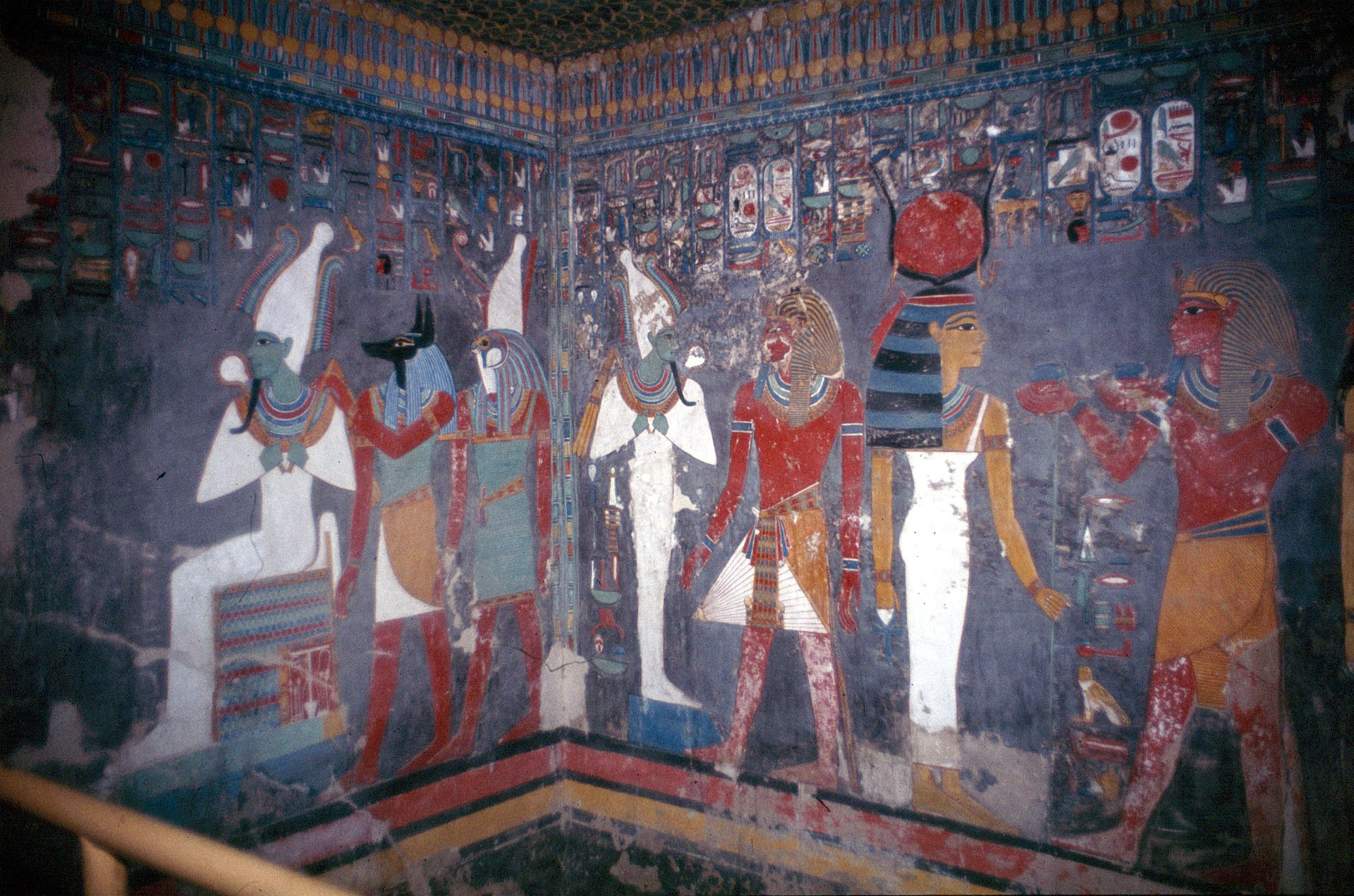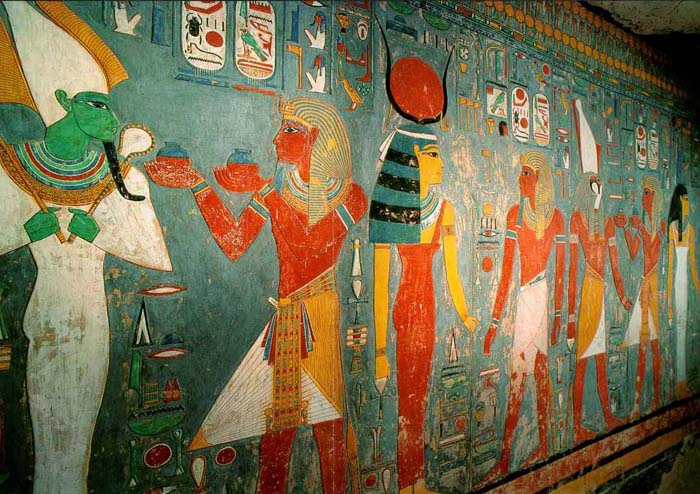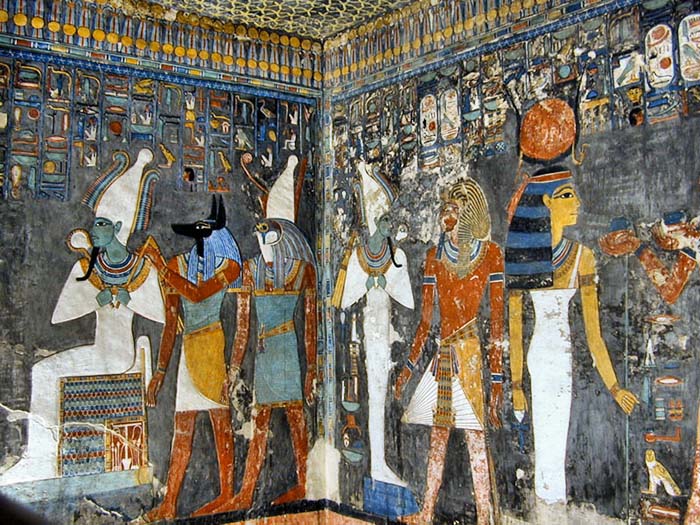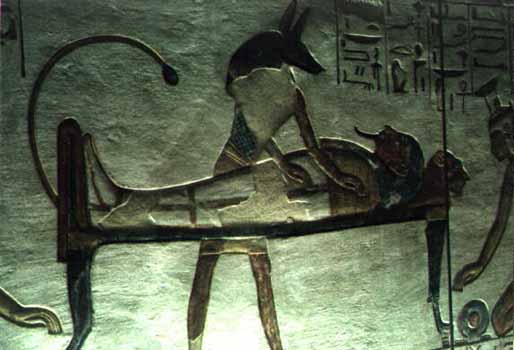

Horemheb (sometimes spelled Horemhab or Haremhab and meaning Horus is in Jubilation) was the last Pharaoh of the 18th Dynasty from either 1319 BC to late 1292 BC or 1306 to late 1292 BC (if he ruled for 14 years) although he was not related to the preceding royal family and is believed to have been of common birth.
Before he became pharaoh, Horemheb was the commander in chief of the army under the reigns of Tutankamun and Ay. After his accession to the throne, he reformed the state and it was under his reign that official action against the preceding Amarna rulers began.
Horemheb demolished monuments of Akhenaten, reusing their remains in his own building projects, and usurped monuments of Tutankhamun and Ay. Horemheb presumably remained childless and he appointed his vizier Paramesse as his successor, who would assume the throne as Ramesses I.
Horemheb is believed to have originated from Herakleopolis Magna or ancient Hnes (modern Ihnasya el-Medina) on the west bank of the Nile near the entrance to the Fayum since his coronation text formally credits the God Horus of Hnes for establishing him on the throne.
His parentage is unknown but he is universally believed to be a commoner. According to the French (Sorbonne) Egyptologist Nicolas Grimal, Horemheb does not appear to be the same person as Paatenemheb (Aten Is Present In Jubilation) who was the Commander-in-chief of Akhenaten's army. Grimal notes that Horemheb's political career first began under Tutankhamun where he "is depicted at this king's side in his own tomb chapel at Memphis."
In the earliest known stage of his life, Horemheb served as "the royal spokesman for [Egypt's] foreign affairs" and personally led a diplomatic mission to visit the Nubian governors. This resulted in a reciprocal visit by "the Prince of Miam (Aniba)" to Tutankhamun's court, "an event [that is] depicted in the tomb of the Viceroy Huy."
Horemheb quickly rose to prominence under Tutankhamun, becoming Commander-in-Chief of the Army, and advisor to the Pharaoh. Horemheb's specific titles are outlined from his Saqqara tomb which was built while he was still only an official: "Hereditary Prince, Fan-bearer on the Right Side of the King, and Chief Commander of the Army"; the "attendant of the King in his footsteps in the foreign countries of the south and the north"; the "King's Messenger in front of his army to the foreign countries to the south and the north"; and the "Sole Companion, he who is by the feet of his lord on the battlefield on that day of killing Asiatics."
When Tutankhamun died while still a teenager, Horemheb had actually been designated as rpat ("Crown Prince") and idnw (King's "Deputy") which meant that Horemheb was the officially recognised heir to Tutankhamun's throne. However, the aged Vizier Ay managed to sideline Horemheb's claim to the throne and instead succeed Tutankhamun. Having pushed Horemheb aside, Ay proceeded to nominate a military officer named Nakhtmin who was possibly Ay's son or adopted son, to succeed him rather than Horemheb.
After Ay's reign which lasted for a little over four years, however, Horemheb managed to seize power presumably from his position as Commander of the Army to assume what he must have perceived to be his just reward for having ably served Egypt under Tutankhamun and Ay. Horemheb quickly removed Naktmin's rival claim to the throne and arranged to have Ay's WV23 tomb desecrated by smashing the latter's sarcophagus into several pieces, systematically chiselling out Ay's name and figure out of the tomb walls and probably destroying Ay's mummy.
However, he spared Tutankhamun's tomb from vandalism presumably because it was the Boy King who had promoted his sudden rise to power and chosen him to be this king's successor. Horemheb also usurped and enlarged Ay's mortuary temple at Medinet Habu for his own use and erased Ay's titulary on the back of a 17 foot colossal statue by carving his own titulary in its place.

Horemheb with Amun at the Museo Egizio

Horemheb with Amun
Upon his accession, Horemheb initiated a comprehensive series of internal transformations to the power structures of Akhenaten's reign, due to the preceding transfer of state power from Amen's priests to Akhenaten's government officials. Horemheb "appointed judges and regional tribunes...reintroduced local religious authorities" and divided legal power "between Upper Egypt and Lower Egypt" between "the Viziers of Thebes and Memphis respectively."
These deeds are recorded in a stela which the king erected at the foot of his Tenth Pylon at Karnak. Occasionally called The Great Edict of Horemheb,[ it is a copy of the actual text of the king's decree to re-establish order to the Two Lands and curb abuses of state authority. The stela's creation and prominent location emphasizes the great importance which Horemheb placed upon domestic reform.
Horemheb also reformed the Army and reorganized the Deir el-Medinah workforce in his 7th Year while Horemheb's official, Maya, renewed the tomb of Thutmose IV, which had been disturbed by tomb robbers in his 8th Year. While the king restored the priesthood of Amun, he did not permit the Amun priests from forming a stranglehold on power by deliberately reappointing priests who mostly came from the Egyptian army since he could rely on their personal loyalty.
Horemheb was a prolific builder who erected numerous temples and buildings throughout Egypt during his life-time. He constructed the Second, Ninth and Tenth Pylons of the Great Hypostyle Hall, in the Temple at Karnak using recycled talatat blocks from Akhenaten's own monuments here, as building material for the first two Pylons.
Because of his unexpected rise to the throne, Horemheb had two tombs constructed for himself: the first - when he was a mere nobleman - at Saqqara near Memphis, and the other - in the Valley of the Kings, in Thebes, in tomb KV57, as king. His chief wife was Queen Mutnedjmet, who may have been Nefertiti's younger sister, but she failed to bear him a successor. He is not known to have any children by his first wife Amenia who died before Horemheb assumed power.
This pharaoh's reign length is a matter of debate among scholars. Horemheb's highest clearly known dates are a pair of Year 13 and Year 14 wine labels from this king's wine estates which were found in his royal tomb in the Valley of the Kings. It is traditionally believed that Horemheb's highest year-date is likely attested in an anonymous hieratic graffito written on the shoulder of a now fragmented statue from his mortuary temple in Karnak which mentions the appearance of the king himself, or a royal cult statue representing the king, for a religious feast.
The ink graffito reads Year 27, first Month of Shemu day 9, the day on which Horemheb, who loves Amun and hates his enemies entered the temple for this event. (1973) No.37 footnote observes that the use of Horemheb's name and the addition of a long "Meryamun" (Beloved of Amun) epithet in the graffito suggests a living, eulogised king rather than a long deceased one.
The Egyptologist Rolf Krauss, in a DE 30(1994) paper, has argued that this date may well reflect Horemheb's accession where a feast or public holiday was traditionally proclaimed to honour the accession date of a deceased or a current king. Krauss supports his hypothesis with evidence from Ostraca IFAO 1254 which was initially published by Jac Janssen in a BIFAO 84(1984) paper under the title "A Curious Error."
The ostraca records the number of days on which an unknown Deir el-Medinah workman was absent from work and covers the period from Year 26 III Peret day 11 to Year 27 II Akhet day 12 before breaking off. The significant fact here is that a Year change occurred in the ostraca from Year 26 to Year 27 around the interval IV Peret day 28 and I Shemu day 13. The Year 27 date of Horemheb is located within this interval and would reflect Horemheb's accession date, Krauss suggests. Ay's accession date occurred somewhere in the month of III Peret.
Since Manetho gives Ay reign of 4 years and 1 month, this ruler would have died sometime around the month of IV Peret or the first half of I Shemu at the very latest. This is precisely the time period noted in Ostraca IFAO 1254. The fact that the ostraca records the case of only one worker rather than an entire group of workmen means the necropolis scribe cannot be presumed - at first glance - to have committed a dating error in altering the unknown king's Year date in the interval between IV Peret 28 and I Shemu 13.
Janssen, in his original BIFAO paper, noted the curious fact that no known New Kingdom pharaohs who reigned for a quarter of a century including Ramesses II and Ramesses III had their accession date in this time frame and suggests the Year change was an error committed on behalf of the scribe. He then attributed the ostraca to Ramesses III, whose accession date was I Shemu day 26 and expressed his view that the scribe may have inadvertently implemented the Year change two weeks early instead. Janssen also observed that the paleography of the ostraca suggests a date in the 20th Dynasty partly because it followed the later New Kingdom form of writing and due to its provenance in the Grand Putit region, which features numerous Dynasty 20 ostracas.
However, this form of writing is also attested in monuments of Ramesses II and it would, therefore, not be unexpected to find it in a document from the very late 18th Dynasty since the transition from the Early New Kingdom to the Late New Kingdom Form of writing had already occurred prior to the end of Horemheb's reign, as Frank Yurco once noted. Indeed, Janssen's palaeographical reference for his paper - Prof. Georges Posener - himself suggested a date in the 19th Dynasty due to the form of the wsf (absent) and akhet (inundation) text. As Janssen himself writes, a few 19th Dynasty ostracas have been found in the Grand Putit area prior to the 20th Dynasty's intensive exploitation of this region.
This does not exclude some late 18th Dynasty work here either. Secondly, both Janssen and Krauss stress in their papers that the relative scarcity of the hieratic text in Ostraca IFAO 1254 precludes a clear dating of the document to Ramesses III's reign and that palaeography, in general, does not give a precise date for a document's creation. Hence, a dating of the ostraca to Horemheb's reign on the basis of the Year change is eminently plausible. On other matters, a damaged wall fragment painting from the Petrie Collection reportedly mentions Horemheb's 15th or 25th Year.
Another important text, The Inscription of Mes, records that a court case decision was rendered in favour by a rival branch of Mes' family in Year 59 of Horemheb. Since the Mes inscription was composed during the reign of Ramesses II when the Amarna-era Pharaohs were struck from the official king-lists, the Year 59 Horemheb date certainly includes the nearly 17 year long reign of Akhenaten, the 2 year independent reign of Neferneferuaten, the 9 year reign of Tutankhamun and the 4 year reign of Ay. Once all these rulers reigns are deducted from the Year 59 date, Horemheb would still have easily enjoyed a reign of 26 - 27 years.

At a well known 1987 Conference from Gothenburg Sweden, Kenneth Kitchen astutely noted that any attempt to explain away the Year 59 Horemheb date as a "scribal error" fails to consider the long and volumnous listed series of court trials and legal setbacks which Mes' family endured in order to win back control over certain valuable lands which had been stolen from his family's line.
Indeed, Mes likely ordered the protracted legal dispute, which is presented as a series of court depositions and testimonies of various plaintiffs and witnesses, to be inscribed on his tomb walls in order to create a permanent ('carved in stone') record of his family's ultimately victorious struggle to win back these lands. Mes, hence, could hardly be expected to forget the beginning of his family's legal tribulations in Year 59 of Horemheb.
Kitchen also observes in his paper that Horemheb's extensive building projects at Karnak supported the theory of a long reign for this Pharaoh and stressed that "a good number of the undated 'late 18th Dynasty' private monuments that are in both Egypt and the world's Museums must, in fact, belong to his reign." Horemheb, hence, probably was assumed to have died after a minimum reign of 27 or, at most, 28 years.
However, the most recent archaeological evidence from 3 excavation seasons conducted under G.T. Martin in 2006 and 2007 establishes that Horemheb most likely died after a maximum reign of 14 years based on a massive hoard of 168 inscribed wine sherds and dockets recently discovered below densely compacted debris in a great shaft (called Well Room E) in this king's royal KV57 tomb.
Of the 46 wine sherds with year dates, 14 have nothing but the year date formula, 5 dockets have Year 10+X, 3 dockets have Year 11+X, 2 dockets preserve Year 12+X and 1 docket has a Year 13+X. Meanwhile, 22 dockets "mention Year 13 and 8 have Year 14 of Horemheb" but none mention a higher date for Horemheb.
Other Year 14 dockets mention Memphis (?), the Western River while their wintners are named as Nakhtamun, Mer-seger-men, Ramose and others.
The "quality and consistency of the KV57 dockets strongly suggest that Horemheb was buried in his Year 14, or at least before the wine harvest of his Year 15 at the very latest." This evidence is consistent "with the Horemheb dockets from Deir el-Medina which mention Years 2, 3, 4, 6, 13 and 14, but again no higher dates"....while a docket ascribed to Horemheb from Sedment has Year 12."
The lack of dated inscriptions for Horemheb after his Year 14 also explains the unfinished state of Horemheb's royal KV57 tomb - "a fact not taken into account by any of those scholars defending a long reign of 26 or 27 years.
The tomb is comparable to that of Seti I in size and decoration technique, and Seti I's tomb is far more extensively decorated than that of Horemheb, and yet Seti managed to virtually complete his tomb within a decade, whereas Horemheb did not even succeed in fully decorating the three rooms he planned to have done, leaving even the burial hall unfinished.
Even if we assume that Horemheb did not begin the work on his royal tomb until his Year 7 or 8,...it remains a mystery how the work could not have been completed had he lived on for another 20 or more years." Therefore, Horemheb's reign has been determined and accepted today by most scholars to be 14 years and 1 month - Manetho had assigned him a reign of 4 years in his Epitome and 1 month - based on the clear evidence of the wine jar labels and the lack of dates beyond his Year 14 but this figure should be raised by a decade.
As for the Year 27 hieratic graffito at Horemheb's Funerary temple at Medinet Habu and the Year 59 date from the inscription of Mes, Van Dijk argues that the first date likely inaugurated a statue of Horemheb during Year 27 of Ramesses II or III in Horemheb's temple while the latter date of Mes "can hardly be taken seriously, and indeed is not taken at face value by even the staunchest supporters of a long reign" for Horemheb since there was no standard Egyptian practice of including the years of all the rulers between Amenhotep III and Horemheb as Wolfgang Helck makes clear.
Under Horemheb, Egypt's power and confidence was once again restored after the internal chaos of the Amarna period; this situation set the stage for the rise of the 19th Dynasty under such ambitious Pharaohs like Seti I and Ramesses II. Horemheb is believed to have unsuccessfully attempted to father an heir to the throne since the mummy of his second wife was found with a fetus in it. Geoffrey Martin in his excavation work at Saqqara states that the burial of Horemheb's second wife Mutnedjmet was located at the bottom of a shaft to the rooms of Horemheb's Saqqara tomb. He notes that "a fragment of an alabaster vase inscribed with a funerary text for the chantress of Amun and King's Wife Mutnodjmet, as well as pieces of a statuette of her was found here. The funerary vase in particular, since it bears her name and titles would hardly have been used for the burial of some other person."
Since Horemheb remained childless, he appointed his Vizier, Paramesse as his chosen successor before his death both to reward Paramesse's loyalty and because the latter had both a son and grandson to secure Egypt's royal succession. Paramesse employed the name Ramesses I upon assuming power and founded the 19th Dynasty of the New Kingdom. While the decorations of Horemheb's KV57 tomb walls was still unfinished upon his death, this situation is not unprecedented: Amenhotep II's tomb was also not fully completed when he was buried but this ruler enjoyed a reign of 26 Years.


